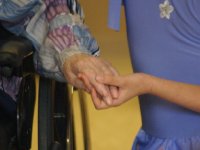Connecting Elders and Students to Improve SEL
Connecting young people to senior citizens is a time-honored strategy for building character and social-emotional learning skills. It is a win-win for both the students and adults involved, creating situations rich with emotions, perspective taking, and shared activity.
One such example that I have come across is the Dear Wise Elders project, which began in the New Brunswick Middle School in New Brunswick, NJ. The developer of the project, David Eisenstein, is a sixth-grade math teacher. He shared with other teachers -- and also with school and district administrators -- a vision that his school, designated as a priority school, could become a school of character, and in so doing, lift the students socially, emotionally, and academically.
In addition to participating in school-wide, social-emotional character development and culture and climate improvement initiatives generated by the school, David added his own innovation, the Dear Wise Elders project. I interviewed David about this project and his vision for its expansion.
Edutopia: What is the Dear Wise Elders project, and what age groups of children are appropriate for it?
David Eisenstein: Dear Wise Elders grew organically out of my work with older adults. I asked a group of seniors for help with a problem I had with my middle school classes. My students did not understand what was really worthy of respect.
The elders and I made a poster expressing all their ideas about respect, and I brought it to my classroom. The kids loved it, and we had a great discussion about respect that ended with the students writing letters thanking the elders and telling them stories about their own grandparents. I read these letters to the elders the following week. Many elders had tears in their eyes as we connected lives across the generations.
These connections helped both groups. Our elders had found new people to talk with, and many found new purpose in helping our children. At school, I found my students had more enthusiasm and enjoyed connecting with the elders. More than a few of my formerly blasé kids were eagerly participating in our morning lessons on SEL.
To foster this work, I created the non-profit, Dear Wise Elders Foundation. Since the crux of the project is to connect the generations, it is a natural fit for the Internet. My plan is to have a safe space online where these connections can foster and grow.
I am sure that all ages will benefit from participating, not just middle school. I have seen the impact with some children as young as six. So the foundation is actively seeking volunteers to help test the program with elementary school children.
Edutopia: What is the lesson plan for teachers who want to implement the Dear Wise Elders concept with their students?
David Eisenstein: That's the beauty of Dear Wise Elders. In our overly complex educational environment, this program is simple. On our website, we posted ten areas of social-emotional learning that the elders seek to improve, along with some simple directions for collecting and transforming content from a group of elders. We also posted a one-page guide for the children's letters.
Anyone with a group of elders or a class of children can be up and running, generating content right away. Our vision is that any group of elders can connect with any class of schoolchildren anywhere in the world using the Internet.
Edutopia: What are the benefits for the wise elders?
David Eisenstein: The benefits for the elders are many, and 98 percent of those elders surveyed said they feel happy about participating. Chief among the health benefits is that working with young people gives our elders purpose and meaning. They awaken each day filled with a sense of excitement for living. This positive mental outlook has wondrous effects on their well-being and quality of life.
Edutopia: How can interested educators get started?
David Eisenstein: Educators can speak with program directors at local senior centers and assisted living facilities and ask them if they'd like their elders to participate. The workers in their facility help the elders create the content and then give the content to the teachers whose classes are participating to use in their classrooms.
What are your thoughts and ideas on this post? Please share in the comments section below.
